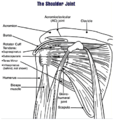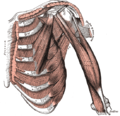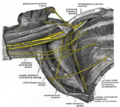Biceps
| Biceps brachii | |
|---|---|
 | |
| Details | |
| Origin | short head: coracoid process of the scapula. long head: supraglenoid tubercle |
| Insertion | radial tuberosity and bicipittal aponeurosis into deep fascia on medial part of forearm |
| Artery | brachial artery |
| Nerve | Musculocutaneous nerve (C5–C7) |
| Actions | flexes elbow and supinates forearm |
| Antagonist | Triceps brachii muscle |
| Identifiers | |
| Latin | musculus biceps brachii |
| TA98 | A04.6.02.013 |
| TA2 | 2464 |
| Anatomical terms of muscle | |
In human anatomy, the biceps brachii (simply biceps in common parlance) is a muscle located on the upper arm. The biceps has several functions, the most important being to rotate the forearm (supination) and to flex the elbow.
Terminology
The term biceps brachii is a Latin phrase meaning "two-headed [muscle] of the arm", in reference to the fact that the muscle consists of two bundles of muscle, each with its own origin, sharing a common insertion point near the elbow joint.
The proper plural form of the Latin adjective biceps is bicipites, a form not in general English use. Instead, biceps is used in both singular and plural (i.e., when referring to both arms). The form bicep [sic], although common even in professional contexts, is considered incorrect.[1] The error may originate from a mistaken belief that biceps is a plural noun (rather than an adjective in the singular), since English typically forms its plurals by the addition of the letter s to the end of a noun.
Anatomy
Proximally, the short head of the biceps attaches to (originates from) the coracoid process of the scapula. The tendon of the long head passes along the intertubercular groove of the humerus into the joint capsule at the head of the humerus, and attaches to the scapula at the supraglenoid tubercle.
Distally, biceps attaches to (inserts into) the radial tuberosity. Because the ulnar and radial bones can rotate about each other the biceps can powerfully supinate the forearm. The biceps also connects with the fascia of the medial side of the forearm via the bicipital aponeurosis.
Two additional muscles lie underneath the biceps brachii. These are the coracobrachialis muscle, which like the biceps attaches to the coracoid process of the scapula, and the brachialis muscle which connects to the ulna and along the mid-shaft of the humerus.
Functions
The biceps is tri-articulate, meaning that it works across three joints. The most important of these functions are to supinate the forearm and flex the elbow.
These joints and the associated actions are listed as follows in order of importance[2]:
- Proximal radioulnar joint - Contrary to popular belief, the biceps brachii is not the most powerful flexor of the forearm, a role which actually belongs to the deeper brachialis muscle. The biceps brachii functions primarily as a powerful supinator of the forearm (turns the palm upwards). This action, which is aided by the supinator muscle, requires the elbow to be at least partially flexed. If the elbow, or humeroulnar joint, is fully extended, supination is then primarily carried out by the supinator muscle.
- Humeroulnar joint (Elbow) - The biceps brachii also functions as an important flexor of the forearm, particularly when the forearm is supinated. Functionally, this action is performed when lifting an object, such as a bag of groceries or when performing a biceps curl. When the forearm is in pronation (the palm faces the ground), the brachialis, brachioradialis, and supinator function to flex the forearm, with minimal contribution from the biceps brachii.
- Glenohumeral joint (Shoulder) - Several weaker functions occur at the glenohumeral, or shoulder, joint. The biceps brachii weakly assists in forward flexion of the shoulder joint (bringing the arm forward and upwards). It may also contribute to abduction (bringing the arm out to the side) when the arm is externally (or laterally) rotated. The short head of the biceps brachii also assists with horizontal adduction (bringing the arm across the body) when the arm is internally (or medially) rotated. Finally, the long head of the biceps brachii, due to its attachment to the scapula (or shoulder blade), assists with stabilization of the shoulder joint when a heavy weight is carried in the arm.
Training
The biceps can be strengthened using weight and resistance training. An example of a well known biceps exercise is the simple biceps curl.
Additional images
-
Location
-
An example of an arm flexed in the pronated position; with the biceps partially contracted.
-
An example of an arm flexed in a supinated position with the biceps fully contracted.
-
Diagram of the human shoulder joint
-
Left scapula. Dorsal surface.
-
Bones of left forearm. Anterior aspect.
-
Deep muscles of the chest and front of the arm, with the boundaries of the axilla.
-
Cross-section through the middle of upper arm.
-
Front of the left forearm. Superficial muscles.
-
The brachial artery.
-
The right brachial plexus (infraclavicular portion) in the axillary fossa; viewed from below and in front.
-
Nerves of the left upper extremity.
See also
References
- ^ Tangled Passages, Corbett, Philip B., February 9, 2010, The New York Times
- ^ Simons David G., Travell Janet G., Simons Lois S. (1999). "30: Biceps Brachii Muscle". In Eric Johnson (ed.). Travell & Simons' Myofascial Pain and Dysfunction (2nd ed.). Baltimore, Maryland: Williams and Wilkins. pp. 648–659. ISBN 0683083635.
{{cite book}}: CS1 maint: multiple names: authors list (link)
link title==External links==
- Template:MuscleLoyola
- Illustration: bicepsbrachii from The Department of Radiology at the University of Washington
- "Biceps brachii muscle". GPnotebook.
- Anatomy photo:06:05-0102 at the SUNY Downstate Medical Center
- Template:Exrx
- Template:Http://www.body-mind-strength.com/weight exercises/free weight bicep exercises.html Free Weight Bicep Exercise Guide











